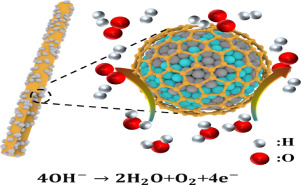Journal of Energy Chemistry ( IF 14.0 ) Pub Date : 2019-12-15 , DOI: 10.1016/j.jechem.2019.12.008 Meng Zha , Chengang Pei , Quan Wang , Guangzhi Hu , Ligang Feng

|
Performance boosting of hybrid metal oxide and metal alloy catalyst is crucial to the water electrolysis for hydrogen generation. Herein, a novel concept of selective fluoridation of metal alloy/oxide hybrid is proposed to boost their catalytic performance for the oxygen evolution reaction (OER). A well-recognized OER catalyst system of FeNi3 alloy/oxide embedded in nitrogen-doped porous nanofibers (FeNiO/NCF) is employed as a proof of concept, and it is selectively fluoridated by transforming the metal oxide to metal fluoride (FeNiF/NCF). The crystal structure and surface chemical state transformation are well supported by the spectroscopic analysis and the improved electrochemical performance for OER can be well correlated to the phase and structure change. Specifically, FeNiF/NCF can drive the benchmark current density of 10 mA cm−2 at 260 mV with a Tafel slope of 67 mV dec−1, about 70 mV less than that of FeNiO/NCF. Increased catalytic kinetics, rapid charge transfer ability, high catalytic efficiency and stability are also probed by electrochemical analysis. The high surface area and roughness are found mainly generated via the high-temperature annealing for the metal alloy/metal oxide formation, and the low-temperature fluoridation process intrinsically contributes to the active structure formation. It is an efficient and universal approach to increase the catalytic performance of metal alloy/oxide for energy-relevant catalytic reactions.
中文翻译:

FeNi 3合金/氧化物杂化物的选择性氟化有效促进了电化学放氧反应
杂化金属氧化物和金属合金催化剂的性能提高对于产生氢的水电解至关重要。在此,提出了一种新颖的金属合金/氧化物杂化体选择性氟化的概念,以提高其对氧释放反应(OER)的催化性能。公认的FeNi 3 OER催化剂体系嵌入氮掺杂的多孔纳米纤维(FeNiO / NCF)中的合金/氧化物被用作概念证明,并且通过将金属氧化物转化为金属氟化物(FeNiF / NCF)对其进行选择性氟化。光谱分析很好地支持了晶体结构和表面化学状态的转变,并且改善的OER电化学性能可以很好地与相变和结构变化相关。具体而言,FeNiF / NCF可以在260 mV时驱动10 mA cm -2的基准电流密度,而Tafel斜率为67 mV dec -1,比FeNiO / NCF大约低70 mV。电化学分析还探讨了增加的催化动力学,快速的电荷转移能力,高的催化效率和稳定性。发现高表面积和粗糙度主要是通过金属合金/金属氧化物形成的高温退火产生的,并且低温氟化过程本质上有助于活性结构的形成。这是一种提高能量相关的催化反应的金属合金/氧化物的催化性能的有效且通用的方法。

































 京公网安备 11010802027423号
京公网安备 11010802027423号